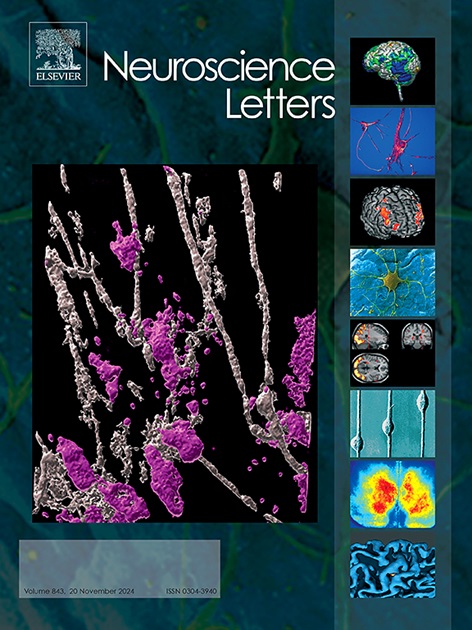CB1受体拮抗剂可逆转大鼠反复暴露于痛苦同种动物引起的社会和认知缺陷。
IF 2
4区 医学
Q3 NEUROSCIENCES
引用次数: 0
摘要
共情是一种行为现象,其特征是能够分享他人的痛苦经历,包括痛苦、歧视和社会排斥。大麻素系统被认为是大脑的神经调节系统之一,似乎在社会和亲社会行为中发挥着重要作用,特别是在移情的背景下。本研究旨在探讨大麻素系统在介导共情疼痛和行为中的潜在作用,这一领域迄今尚未得到彻底的探索。为此,采用了共情疼痛模型,其中疼痛从接受五次福尔马林注射的兄弟姐妹示范者社会传播给兄弟姐妹观察者。Naïve观察大鼠分别给予大麻素1型受体(CB1R)拮抗剂利莫那班(1 mg/kg, i.p)或CB1R激动剂WIN 55,212-2 (WIN;3 mg/kg, i.p.) 30 分钟前行为评估。这些动物随后通过甩尾和社会互动任务进行评估。行为研究结果显示,示范组和观察组都表现出痛觉过敏和社会记忆障碍的显著增加。值得注意的是,给予利莫那班,而不是WIN,部分恢复了观察大鼠的认知功能并诱导了镇痛。此外,实验大鼠和观察大鼠海马脑源性神经营养因子(BDNF)水平均下降,而与WIN相比,给予利莫那班导致海马BDNF水平升高。这些结果表明,CB1R可能复杂地参与亲社会行为和情绪感染,可能通过调节海马中的BDNF水平。本文章由计算机程序翻译,如有差异,请以英文原文为准。
CB1 receptor antagonism reverses social and cognitive deficits induced by repeated exposure to distressed conspecifics in rats
Empathy is a behavioral phenomenon characterized by the capacity to share in another individual’s distressing experiences, including pain, discrimination, and social rejection. The cannabinoid system, recognized as one of the brain’s neuromodulatory systems, appears to play a significant role in social and prosocial behaviors, particularly in the context of empathy. This study aimed to investigate the potential role of the cannabinoid system in mediating empathic pain and behavior, an area that has not been thoroughly explored to date. To this end, an empathic pain model was employed, wherein pain was socially transmitted from a sibling demonstrator, who received five formalin injections, to a sibling observer. Naïve observer rats were administered either the cannabinoid type 1 receptor (CB1R) antagonist rimonabant (1 mg/kg, i.p.) or the CB1R agonist WIN 55,212–2 (WIN; 3 mg/kg, i.p.) 30 min prior to behavioral assessments. The animals were subsequently evaluated using tail-flick and social interaction tasks. The behavioral findings revealed that both the demonstrator and observer groups exhibited significant increases in hyperalgesia and impairments in social memory. Notably, the administration of rimonabant, but not WIN, partially restored cognitive functions and induced analgesia in the observer rats. Furthermore, hippocampal levels of brain-derived neurotrophic factor (BDNF) decreased in both demonstrator and observer rats, whereas rimonabant administration resulted in an increase in BDNF levels in the hippocampus, in contrast to WIN. These results suggest that the CB1R may be intricately involved in prosocial behavior and emotional contagion, potentially through the modulation of BDNF levels in the hippocampus.
求助全文
通过发布文献求助,成功后即可免费获取论文全文。
去求助
来源期刊

Neuroscience Letters
医学-神经科学
CiteScore
5.20
自引率
0.00%
发文量
408
审稿时长
50 days
期刊介绍:
Neuroscience Letters is devoted to the rapid publication of short, high-quality papers of interest to the broad community of neuroscientists. Only papers which will make a significant addition to the literature in the field will be published. Papers in all areas of neuroscience - molecular, cellular, developmental, systems, behavioral and cognitive, as well as computational - will be considered for publication. Submission of laboratory investigations that shed light on disease mechanisms is encouraged. Special Issues, edited by Guest Editors to cover new and rapidly-moving areas, will include invited mini-reviews. Occasional mini-reviews in especially timely areas will be considered for publication, without invitation, outside of Special Issues; these un-solicited mini-reviews can be submitted without invitation but must be of very high quality. Clinical studies will also be published if they provide new information about organization or actions of the nervous system, or provide new insights into the neurobiology of disease. NSL does not publish case reports.
 求助内容:
求助内容: 应助结果提醒方式:
应助结果提醒方式:


